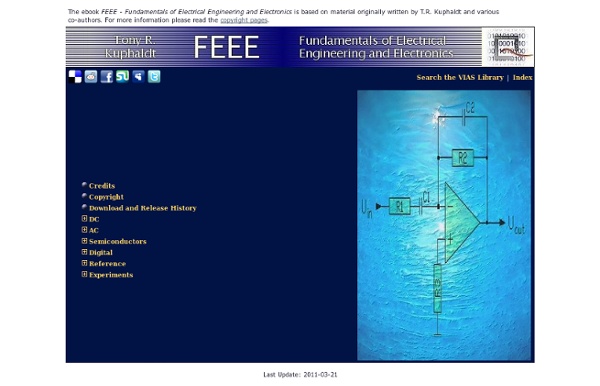



Series and parallel circuits A series circuit with a voltage source (such as a battery) and 3 resistors A circuit composed solely of components connected in series is known as a series circuit; likewise, one connected completely in parallel is known as a parallel circuit. In a series circuit, the current through each of the components is the same, and the voltage across the circuit is the sum of the voltages across each component.[1] In a parallel circuit, the voltage across each of the components is the same, and the total current is the sum of the currents through each component.[3] In a series circuit, every device must function for the circuit to be complete. Series circuits A series circuit's main disadvantage or advantage, depending on its intended role in a product's overall design, is that because there is only one path in which its current can flow, opening or breaking a series circuit at any point causes the entire circuit to "open" or stop operating. Current Resistors Inductors and . Therefore By reciprocity If .
Download Center Download Center - EEP (Learning center for electrical engineers) Welcome to EEP’s Download Center! There are three main sections which covers electrical books & guides, software & tools and design documentation. Feel free to explore our great recourses, and if you have any suggestions or complaints please contact us. EEP’s Download Center provides greatest resource for education and learning in field of electricity science. All documents are completely free to download. Books & Guides Electric power books are divided into few sections, so it is easy for power engineers to find appropriate book, guide or information related to power engineering, automation, industry etc. - Electrical Eng. Explore section Software & Tools Electrical design without appropriate software and tools is impossible to imagine. - CalcuLuX Area - DIALux - Relux - Ecodial - Visual Design Docs Almost every electrical design project has some documents repeating from one to another project with some modifications.
Circuit Theory/Laplace Transform Laplace Transform[edit] The Laplace Transform is a powerful tool that is very useful in Electrical Engineering. The transform allows equations in the "time domain" to be transformed into an equivalent equation in the Complex S Domain. The laplace transform is an integral transform, although the reader does not need to have a knowledge of integral calculus because all results will be provided. This page will discuss the Laplace transform as being simply a tool for solving and manipulating ordinary differential equations. Laplace transformations of circuit elements are similar to phasor representations, but they are not the same. , while the Laplace transform uses the variable s. The transform is named after the mathematician Pierre Simon Laplace (1749-1827). Laplace Domain[edit] The Laplace domain, or the "Complex s Domain" is the domain into which the Laplace transform transforms a time-domain equation. s is a complex variable, composed of real and imaginary parts: The Transform[edit] . of
College Instrumentation Specialist - NEETS * These files are Adobe Acrobat files that are 100-400 pages in length and depending on your ISP connection speed may take some time to open. You can also save these files directly to your computer without opening them by right-clicking on the link then select "Save Target As". All text below is copied directly from the forward that is in each NEETS manual: The Navy Electricity and Electronics Training Series (NEETS) was developed for use by personnel in many electrical and electronic related Navy ratings. The series is designed to give small amounts of information that can be easily digested before advancing further into the more complex material. Module 1 - Introduction to Matter, Energy and Direct Current, introduces the course with a short history of electricity and electronics and proceeds into the characteristics of matter, energy and direct current (DC). Module 8 - Introduction to Amplifiers, covers amplifiers. Module 20 - Master Glossary, is the glossary of terms for the series.
Preparing the circuit Since I have no experience in electronics whatsoever, this was the toughest part for me to find out. Other instructables had no good explaining on this subject. So for everyone who's new to this electronics stuff and have no idea what they're doing, here is some explaining for the circuit. 1. How many LED's to use? So if you use a 12v adapter with the 3v LED's its: 12 / 3 = 4 LED's You can also put LED's parallel in the circuit. 2. So that means I can calculate the LED's again: 18 / 3 = 6 LED's. Since I'm going to make the LED's in series I can use 6 LED's in my circuit. 3. Now with this information you can go to the next step, building the circuit.
Cook Your Own Distortion Making your own distortion design is easy. So why not design your very own distortion effect? [ Back to Main | Download ] History of Distortions In the mid 50's, when electric guitars became popular, all amplifiers were designed for vocals, and they didn't really give the edge guitarists wanted. The only way to get distortion was to turn volume to eleven and hope the tubes didn't melt (or the neighbors didn't call the cops =). Types of Distortion When talking about distortion, you can usually hear the words overdrive, distortion, fuzz and crunch. Creating distortion The ultimate distortion/overdrive comes from tubes which are overdriven so that it creates a smooth singing sound. 1) Overdriving transistors Just like overdriving tubes, transistors are being overdriven by setting them to run at the top of the amplification range. 2) "Hard" diode clipping This is a very common way to create distortion. 3) "Soft" diode clipping Another very common method. 4) Special methods Opamps Example circuit: